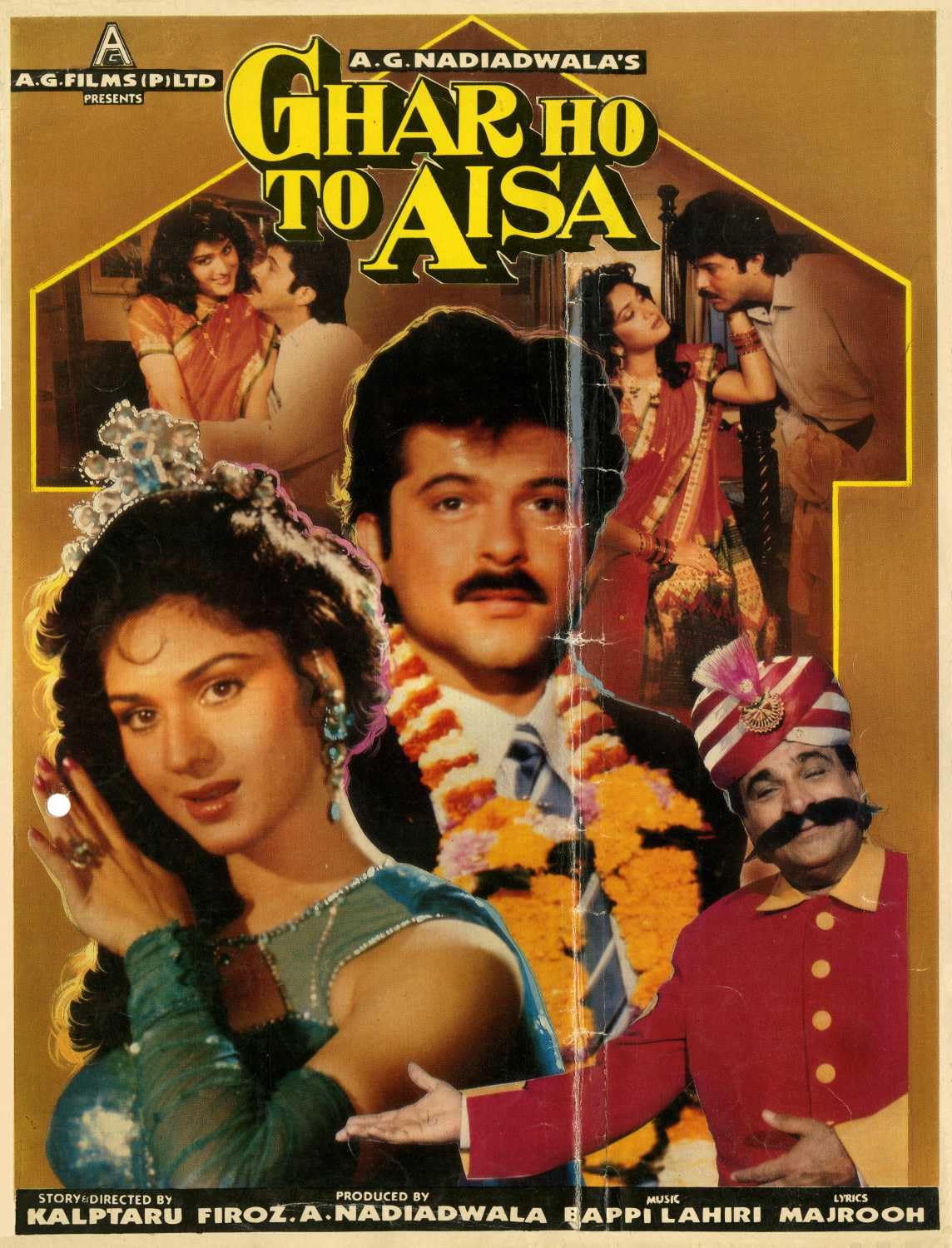Starcast :- Anil Kapoor, Meenakshi Seshadri, Raj Kiran, Deepti Naval, Om Prakash, Saeed Jaffery, Kader Khan and Bindu Direction :- Kalpata...
Starcast :- Anil Kapoor, Meenakshi Seshadri, Raj Kiran, Deepti Naval, Om Prakash, Saeed Jaffery, Kader Khan and Bindu
Direction :- Kalpataru
Music :- Bappi Lahiri
Ghar Ho To Aisa (1990), directed by Kalpataru and
produced by Firoz Nadiadwala, is a quintessential Bollywood family drama that
delves into the complexities of familial relationships and societal issues.
Starring Anil Kapoor, Meenakshi Seshadri, Deepti Naval, Raj Kiran, Kader Khan,
and Bindu, the film addresses themes of domestic abuse, toxic family dynamics,
and redemption. Released on April 27, 1990, during the Eid festival, it
resonated with audiences for its emotional depth and social commentary,
achieving significant box-office success and later inspiring a Telugu remake,
Attintlo Adde Mogudu. While the film occasionally leans on melodramatic tropes,
its powerful performances and compelling narrative make it a notable entry in
Bollywood’s family drama genre.
Storyline:
The film centers on the dysfunctional Kumar family, led by patriarch Ramprasad
(Saeed Jaffrey) and his domineering wife, Durga (Bindu). Their household
includes their married son Vijay (Raj Kiran), his oppressed wife Sharda (Deepti
Naval), their unmarried son Amar (Anil Kapoor), their daughter Kanchan, her
husband Bajrangi (Kader Khan), and their granddaughter Pinky. Sharda faces
relentless abuse from Durga, Vijay, and Kanchan, who exploit her as a household
servant, subjecting her to physical and emotional torment, including a
harrowing incident where her arm is burned in scalding water. The narrative
highlights the grim reality of dowry-related abuse, as Sharda is pressured to
extract money from her impoverished mother, Devki, a servant living in a dilapidated
home.
The plot escalates when Amar, a kind-hearted soul, secures a job with
Dwarkaprasad and falls in love with his spirited daughter, Seema (Meenakshi
Seshadri). Upon returning from a trip to Delhi, Amar discovers that Sharda,
Pinky, and Devki have died under suspicious circumstances. Devastated, he and
Seema infiltrate the Kumar household to expose its toxicity and seek justice.
The story unfolds with twists, blending tension, drama, and moments of dark
comedy, ultimately delivering a message of retribution and redemption. While
the narrative’s social commentary on domestic abuse is poignant, it
occasionally succumbs to predictable Bollywood conventions, slightly diluting
its impact.
Direction and Other Technical Departments:
Kalpataru’s direction is effective in balancing the film’s emotional weight
with its dramatic and comedic elements. He adeptly highlights the contrast
between the Kumar family’s cruelty and the protagonists’ quest for justice,
though some scenes feel overly theatrical, reflecting the era’s stylistic
preferences. The screenplay, while engaging, relies on convenient plot devices,
which may feel dated to modern audiences. Cinematography captures the
claustrophobic tension of the Kumar household, with close-ups emphasizing the characters’
emotional turmoil. However, the film’s production values, including set design
and costumes, are modest, typical of early 1990s Bollywood.
Editing is functional but uneven, with certain sequences dragging due to
prolonged emotional outbursts. The film’s 2-hour-35-minute runtime feels
slightly bloated, and tighter pacing could have enhanced its impact. Action
sequences, though minimal, are competently choreographed, and the film’s
technical execution aligns with the standards of its time. Overall, the
technical departments support the storytelling adequately but lack the polish
of more ambitious productions.
Music:
The soundtrack, composed by Bappi Lahiri, complements the film’s emotional and
dramatic tone. Songs like “Aage Aage Challewali” and “Tu mera navda” are
quintessential Bollywood numbers, blending catchy melodies with situational
relevance. While the music doesn’t rank among Lahiri’s most iconic works, it
effectively underscores key moments, particularly in the lighter second half
where Seema’s antics inject humor. The background score amplifies the film’s
tension and pathos, though it occasionally feels heavy-handed. The songs,
performed by playback singers typical of the era, are well-integrated but not
particularly memorable beyond the film’s context.
Performances:
The film’s strength lies in its stellar ensemble. Anil Kapoor delivers a
nuanced performance as Amar, balancing vulnerability and determination with
ease. Meenakshi Seshadri shines as Seema, her feisty and transformative arc
providing a stark contrast to Deepti Naval’s tragic Sharda. Naval’s portrayal
is heart-wrenching, capturing the quiet suffering of an abused daughter-in-law
with remarkable restraint. Bindu is chilling as the tyrannical Durga, embodying
the archetype of the cruel mother-in-law with conviction. Raj Kiran, as the
complicit Vijay, is suitably detestable, though his role lacks depth. Kader Khan, widely appreciated for his role as Bajrangi, the ghar jamai
(son-in-law living with his in-laws), brings a delightful mix of humor and
heart to the film. His comedic timing and emotional moments, particularly as
one of the few empathetic family members, make him a standout, earning praise
from audiences and critics alike. Supporting actors, including Saeed Jaffrey
and the child actress playing Pinky, add authenticity to the ensemble, along
with Om Prakash who play’s Meenakshi’s father, though some minor characters
feel underdeveloped.
Conclusion:
Ghar Ho To Aisa remains a compelling family drama that tackles serious societal
issues with a blend of emotion, drama, and occasional humor. Its exploration of
domestic abuse and toxic family dynamics is both powerful and relevant, despite
moments of melodrama and conventional storytelling. Kalpataru’s direction,
coupled with strong performances—particularly from Anil Kapoor, Meenakshi
Seshadri, Deepti Naval, and the widely appreciated Kader Khan—elevates the film
above its technical limitations. Bappi Lahiri’s music adds emotional resonance,
though it’s not the film’s defining feature. While not a cinematic masterpiece,
Ghar Ho To Aisa succeeds as an engaging and thought-provoking drama that
resonates with fans of classic Bollywood. Its box-office success and enduring
appeal underscore its significance in the genre, making it a worthy watch for
those seeking a blend of social commentary and heartfelt storytelling.











No comments